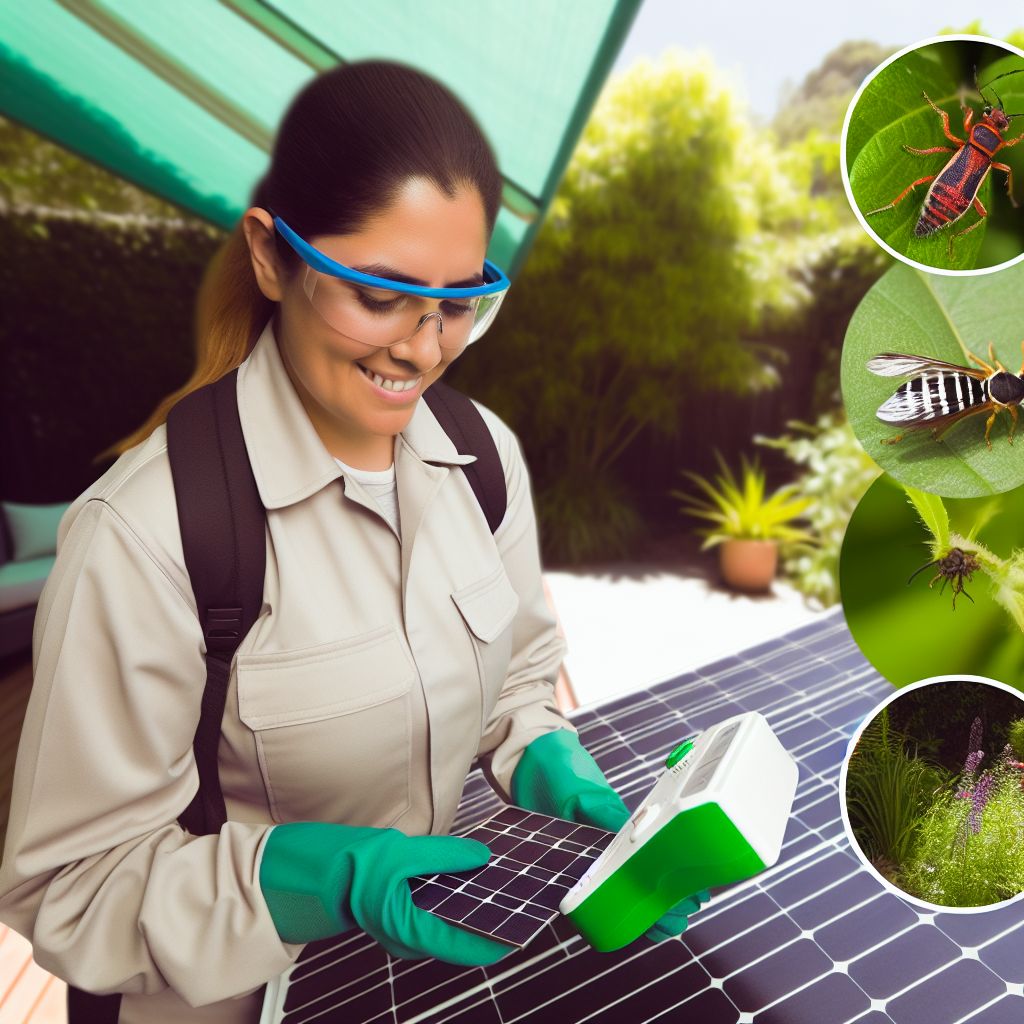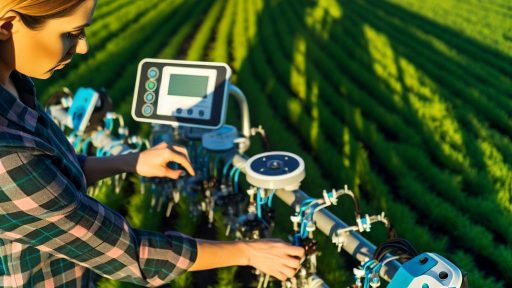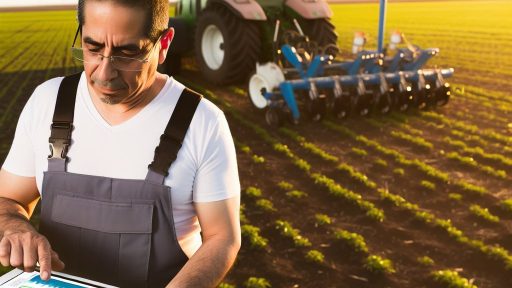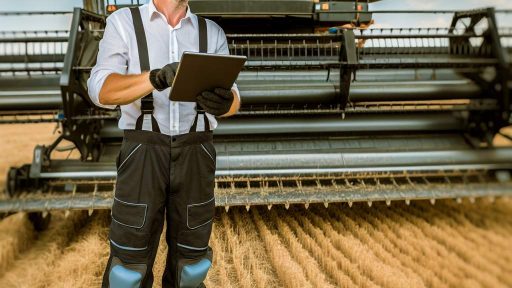Introduction to Sustainable Pest Management in Commercial Real Estate
Sustainable pest management plays a vital role in commercial real estate.
It prioritizes environmental health while effectively controlling pests.
Moreover, it helps maintain the safety of indoor environments for tenants.
Adopting sustainable practices can significantly reduce chemical usage.
This approach not only supports ecosystem health but also enhances property value.
Many property managers and owners are increasingly recognizing its importance.
They understand the need for cost-effective and environmentally friendly solutions.
Effective pest control strategies can mitigate risks associated with pest infestations.
Transitioning to sustainable methods can improve public perception of properties.
Next, we will explore key principles underlying sustainable pest management.
Key Principles of Sustainable Pest Management
The first principle emphasizes prevention and monitoring.
Identifying potential pest sources helps in reducing infestations.
Additionally, establishing thresholds for pest activity is crucial.
Next, effective identification of pests ensures proper treatment.
Using Integrated Pest Management (IPM) practices is another essential principle.
Transform Your Agribusiness
Unlock your farm's potential with expert advice tailored to your needs. Get actionable steps that drive real results.
Get StartedIPM combines cultural, physical, and biological controls with chemical methods.
This integrated approach minimizes adverse environmental impacts.
Another principle is the use of least toxic products when necessary.
Furthermore, regular training and education for staff is crucial.
It ensures everyone is informed about sustainable practices.
Benefits of Sustainable Pest Management
Implementing sustainable pest management offers several key benefits.
First, it enhances the health and safety of occupants.
Secondly, it reduces reliance on harmful pesticides.
Consequently, this fosters a healthier indoor environment.
It also contributes to lower operating costs over time.
Moreover, sustainable practices can lead to regulatory compliance.
This translates into fewer headaches regarding pest-related complaints.
Finally, attracting environmentally conscious tenants becomes easier.
As a result, properties can enjoy enhanced marketability.
Next, we will discuss effective strategies for implementation.
Effective Strategies for Implementation
Creating a comprehensive pest management plan is essential.
Property managers should start with a thorough risk assessment.
Identifying vulnerable areas can aid in proactive measures.
Regular inspections will help catch potential issues early.
Additionally, fostering communication with tenants is beneficial.
Encouraging tenants to report pest sightings promptly can mitigate risks.
Moreover, collaborating with certified pest management professionals is vital.
They can provide expertise and guidance tailored to specific properties.
Training staff on pest identification and prevention is equally important.
Showcase Your Farming Business
Publish your professional farming services profile on our blog for a one-time fee of $200 and reach a dedicated audience of farmers and agribusiness owners.
Publish Your ProfileThis builds a knowledgeable team ready to address issues effectively.
Understanding Common Pests in Commercial Properties
Identifying Common Pests
Commercial properties often encounter a variety of pests.
Each pest presents unique challenges for property management.
Common pests include rodents, insects, and birds.
Identifying these pests promptly is essential for control.
For instance, rodents often seek food and shelter indoors.
Additionally, insects like ants and termites can cause significant damage.
Birds, such as pigeons, can create unsanitary conditions in urban areas.
Factors Contributing to Pest Infestations
Several factors increase the likelihood of pest infestations.
Proximity to food sources attracts pests to commercial properties.
Improper waste disposal provides a breeding ground for insects.
Also, structural flaws can create entry points for rodents.
Seasonal changes influence pest activity patterns.
For example, warmer months may see an increase in insect populations.
Adaptations in pest behavior may also occur due to environmental factors.
Common Types of Pests and Their Impact
Rodents pose serious health risks and property damage.
Common rodents include mice and rats.
Both can contaminate food supplies and spread disease.
Insects, like cockroaches and flies, contribute to unsanitary conditions.
Termites are particularly destructive, targeting wooden structures.
Birds can also create health hazards and damage property.
Cleaning and maintenance practices play a major role in prevention.
Recognizing Signs of Infestation
Regular inspections help identify pest infestations early.
Common signs include droppings, gnaw marks, and nesting materials.
Unusual noises within walls may indicate rodent activity.
Insect activity might also be visible through damaged materials.
Additionally, stagnant water can attract unwanted pests.
Prompt action is necessary upon noticing these signs.
The Importance of Sustainability in Pest Management
Protecting the Environment
Sustainable pest management practices minimize environmental harm.
These practices reduce pesticide use and lower chemical exposure.
Consequently, they protect beneficial organisms and ecosystems.
By using safer alternatives, we foster healthier habitats.
Health Benefits for Occupants
Commercial real estate properties must prioritize occupant health.
Non-toxic pest management strategies enhance indoor air quality.
Furthermore, this approach reduces health risks for employees and clients.
Safeguarding health leads to increased productivity and satisfaction.
Regulatory Compliance
Regulations often mandate sustainable pest management practices.
Businesses that adopt these strategies avoid fines and legal complications.
Compliance reflects positively on their commitment to safety.
Moreover, it enhances their reputation in the community.
Showcase Your Farming Business
Publish your professional farming services profile on our blog for a one-time fee of $200 and reach a dedicated audience of farmers and agribusiness owners.
Publish Your ProfileCost-Effectiveness
Investing in sustainable practices can lead to long-term savings.
For example, integrated pest management reduces the need for frequent interventions.
Saving money on chemicals and treatments improves overall efficiency.
Additionally, healthier environments may lead to fewer distractions.
Building a Sustainable Brand
Embracing sustainability attracts environmentally conscious clients.
As a result, businesses can differentiate themselves in a competitive market.
A commitment to sustainability enhances brand loyalty.
Moreover, it fosters a positive company culture among stakeholders.
You Might Also Like: Greenhouse Development for Suburban Property Owners
Integrated Pest Management Strategies for Commercial Real Estate
Defining Integrated Pest Management
Integrated Pest Management, or IPM, focuses on long-term prevention.
This approach combines various management strategies and practices.
It promotes environmentally friendly solutions to pest problems.
Furthermore, IPM aims to minimize the use of hazardous materials.
Key Strategies for Effective IPM
First, proper identification of pests is crucial.
This enables targeted management and treatment solutions.
Next, monitoring pest populations regularly helps in understanding trends.
Regular inspections detect infestations early, allowing for swift action.
Utilizing Biocontrol Methods
Biological control involves using natural predators to manage pests.
This method reduces the need for synthetic chemicals.
For instance, ladybugs can effectively control aphid populations.
Consequently, implementing biocontrol promotes ecosystem balance.
Implementing Cultural Controls
Cultural controls modify the environment to deter pests.
For example, proper sanitation helps eliminate pest habitats.
Additionally, rotating crops can disrupt pest life cycles.
These practices reduce pest populations without chemical applications.
Incorporating Physical Barriers
Physical barriers prevent pests from accessing properties.
Examples include screens, insect traps, and pest-proof containers.
These barriers effectively minimize pest entry and nesting.
As a result, properties maintain a cleaner and safer environment.
Safe Chemical Use
When necessary, selecting low-risk pesticides is essential.
Pesticides must target specific pests to minimize harm to non-target species.
Additionally, following label instructions ensures safe application.
Always consider timing and weather conditions to increase effectiveness.
Staff Training and Awareness
Training staff in IPM practices enhances overall pest management efforts.
This training promotes awareness of potential pest threats.
Furthermore, it encourages staff to identify issues early.
Regular workshops help reinforce these strategies continually.
Engaging Professional Pest Management Services
Professional pest management services bring expertise to IPM strategies.
These services offer tailored solutions based on specific property needs.
Regular consultations ensure that management practices evolve.
Showcase Your Farming Business
Publish your professional farming services profile on our blog for a one-time fee of $200 and reach a dedicated audience of farmers and agribusiness owners.
Publish Your ProfileMoreover, they stay updated on the latest pest control technologies.
Learn More: Conservation Tillage Research Insights for Agricultural Success
Biological Control Methods for Sustainable Pest Management
Overview of Biological Control
Biological control utilizes natural predators to manage pest populations.
This method helps reduce reliance on chemical pesticides.
Additionally, it promotes a healthier ecosystem in commercial properties.
Types of Biological Control Agents
Several types of agents can be used for pest management.
- Predators: These organisms hunt pests directly.
- Parasitoids: They lay eggs inside pest hosts, leading to their demise.
- Pathogens: These are microorganisms that cause diseases in pests.
Each agent plays a vital role in controlling pest populations effectively.
Implementing Biological Control
Integrating biological control requires careful planning.
First, identify the specific pests affecting the property.
Next, research potential biological agents that target these pests.
Collaboration with pest management professionals is crucial for success.
Benefits of Biological Control
Biological control offers numerous advantages over traditional methods.
- It reduces environmental impact significantly.
- This method enhances biodiversity on properties.
- It promotes long-term pest management solutions.
Moreover, biological control often leads to cost savings over time.
Challenges and Considerations
Despite its benefits, biological control has challenges.
Success relies on selecting the appropriate agent for the pest.
Additionally, climatic conditions can influence effectiveness.
Regular monitoring and adjustments may be necessary for optimal results.
Discover More: Greenhouse Cultivation for Organic Crop Production in the USA
Chemical Control: Choosing Eco-Friendly Pesticides
Understanding Eco-Friendly Pesticides
Eco-friendly pesticides minimize harm to the environment.
They offer effective pest control without toxic chemicals.
Choosing these products supports sustainable pest management practices.
Types of Eco-Friendly Pesticides
Several types of eco-friendly pesticides are available.
Natural insecticides, such as neem oil, work effectively against pests.
Microbial pesticides utilize bacteria or fungi to target specific pests.
Botanical insecticides derived from plant extracts are also popular.
These options significantly reduce the chemical load on properties.
Benefits of Eco-Friendly Pesticides
Using eco-friendly pesticides enhances safety for humans and pets.
They reduce the risk of chemical resistance in pest populations.
Moreover, these pesticides are often less harmful to beneficial insects.
As a result, they help maintain a balanced ecosystem on commercial properties.
Selecting the Right Eco-Friendly Pesticide
When choosing eco-friendly pesticides, consider the target pest.
Understand the life cycle of the pest for effective control.
Evaluate the environmental impact of each pesticide option.
Consult with professional pest management services for guidance.
Application Techniques
Proper application techniques are crucial for eco-friendly pesticides.
Follow the manufacturer’s instructions for optimal results.
Timing the application can enhance effectiveness against pests.
Utilize spot treatments to minimize pesticide use on non-target areas.
Monitoring and Adjusting Strategies
After applying eco-friendly pesticides, regular monitoring is essential.
Evaluate pest activity and adjust strategies as needed.
Showcase Your Farming Business
Publish your professional farming services profile on our blog for a one-time fee of $200 and reach a dedicated audience of farmers and agribusiness owners.
Publish Your ProfileImplement integrated pest management practices for continuous improvement.
This approach ensures long-term effectiveness and sustainability.
See Related Content: The Business Case For Integrating Data-Driven Farming Into Property Ventures

Monitoring and Assessment Techniques for Pest Management
Importance of Regular Monitoring
Regular monitoring identifies pest problems early.
It allows for timely intervention and minimizes damage.
Furthermore, regular inspections maintain the property’s value.
Visual Inspections
Conducting visual inspections is a fundamental technique.
Inspect areas such as basements, attics, and air ducts.
Look for signs of infestations, including droppings and nests.
Document findings to track pest activity over time.
Trap Utilization
Traps serve as an effective monitoring tool.
Use sticky traps or baited traps for various pests.
Regularly check and maintain these traps to ensure accuracy.
Analyze trap results to make informed pest management decisions.
Data Collection and Analysis
Collecting data enables a better understanding of pest patterns.
Maintain records of pest sightings and treatments implemented.
Use this data to identify trends and predict future infestations.
Employ analytical tools for deeper insights into pest behavior.
Utilizing Technology
Technology enhances pest management efficiency.
Consider using mobile apps for real-time monitoring.
Cameras can provide visual evidence of pest issues remotely.
Automated systems send alerts for unusual activity.
Collaboration with Pest Management Professionals
Partnering with pest management experts adds value.
Professionals offer comprehensive assessments of pest risks.
They provide tailored recommendations based on property needs.
Moreover, expert insights enhance the effectiveness of prevention strategies.
Importance of Employee Training
Training staff in pest identification fosters vigilance.
Employees can alert management to potential problems quickly.
Educated staff contribute to overall pest management success.
Incorporate regular training sessions to keep knowledge current.
Employee Training and Awareness in Pest Prevention
Importance of Education
Effective pest management begins with employee education.
Trained staff can identify pests early.
This early detection prevents infestations from escalating.
Moreover, well-informed employees contribute to a healthier environment.
Training Programs
Develop comprehensive training programs tailored for your staff.
Include information on pest identification and prevention strategies.
Offer hands-on workshops to enhance practical skills.
Regular updates are crucial in keeping knowledge current.
Creating Awareness
Awareness campaigns can emphasize the importance of pest management.
Utilize posters and flyers around the workplace.
Showcase Your Farming Business
Publish your professional farming services profile on our blog for a one-time fee of $200 and reach a dedicated audience of farmers and agribusiness owners.
Publish Your ProfileHost informational meetings to discuss pest-related issues.
Encourage employees to report pest sightings immediately.
Engagement and Responsibility
Promote a culture of responsibility among employees.
Recognize individuals or teams who excel in pest prevention.
This recognition can motivate others to engage actively.
Regularly review pest management policies to ensure compliance.
Feedback and Continuous Improvement
Encourage employees to provide feedback on pest management practices.
This feedback can uncover areas needing improvement.
Adjust training programs based on employee input.
Continuously evolving your approach ensures ongoing effectiveness.
Case Studies: Successful Implementation of Sustainable Pest Management
Overview of Case Studies
This section highlights various case studies.
These studies showcase effective sustainable pest management practices.
Also, they demonstrate real-world applications across commercial properties.
Case Study: GreenSky Corporation
GreenSky Corporation faced significant pest issues in its urban office building.
To address this, they employed integrated pest management techniques.
Initially, they conducted a thorough pest inspection.
Next, they identified pest entry points and potential food sources.
Then, they implemented exclusion methods to block pests from entering.
Additionally, they utilized non-toxic traps to monitor pest activity.
As a result, pest populations decreased significantly, improving the work environment.
Case Study: Riverside Retail Mall
Riverside Retail Mall encountered a recurring rodent problem.
The management team decided to switch to sustainable methods.
They started by conducting an environmental assessment of the property.
Following this, they eliminated clutter to reduce rodent harborage.
The team also trained staff on pest awareness and prevention.
Moreover, they employed natural predators to manage rodent populations.
Consequently, this approach yielded a notable reduction in rodent sightings.
Case Study: Eco-Friendly Manufacturing Facility
An eco-friendly manufacturing facility adopted sustainable pest management.
They began by using proactive inspections every month.
The facility employed beneficial insects to control pest populations naturally.
Additionally, they maintained detailed records of pest activity.
This data allowed for informed decision-making and timely interventions.
Overall, the facility reported fewer pest incidents and enhanced product safety.
Key Lessons from Case Studies
These case studies offer valuable insights for businesses.
Firstly, thorough inspections are crucial in pest detection.
Secondly, employing a combination of techniques enhances effectiveness.
Moreover, educating staff plays a vital role in prevention efforts.
Finally, monitoring and adapting strategies ensure ongoing success.
Future Trends in Pest Management for Commercial Properties
Integration of Technology
Technology will play a crucial role in pest management.
Smart sensors can detect pest activity early.
Showcase Your Farming Business
Publish your professional farming services profile on our blog for a one-time fee of $200 and reach a dedicated audience of farmers and agribusiness owners.
Publish Your ProfileFurthermore, drones can monitor large commercial properties.
This integration allows for quick responses to infestations.
Biological Control Methods
Biological control continues to gain popularity.
Utilizing natural predators helps manage pest populations effectively.
Additionally, this method reduces reliance on chemical treatments.
As a result, it promotes environmental sustainability.
Data-Driven Strategies
Data analytics will reshape pest management strategies.
Businesses can leverage data to predict pest outbreaks.
This proactive approach minimizes potential infestations.
Moreover, data allows for tailored pest management plans.
Regulatory and Environmental Considerations
Regulatory changes will influence pest management practices.
Companies must stay compliant with evolving regulations.
This compliance often encourages the use of greener solutions.
Consequently, firms will focus on sustainable pest management options.
Training and Education
Continuous training for staff will be essential.
Educated employees can identify pest issues early.
Additionally, they will implement best practices effectively.
Therefore, ongoing education promotes a pest-free environment.
Additional Resources
AGRI Sustainable Agriculture Demonstration Grant | Minnesota …




